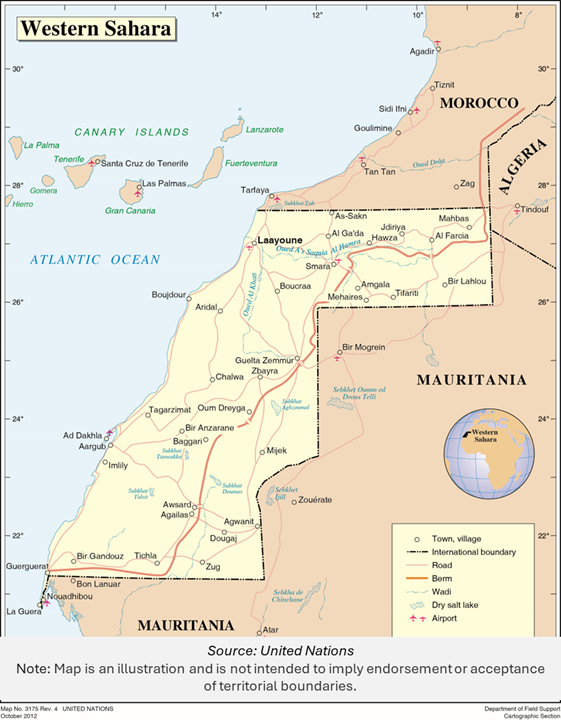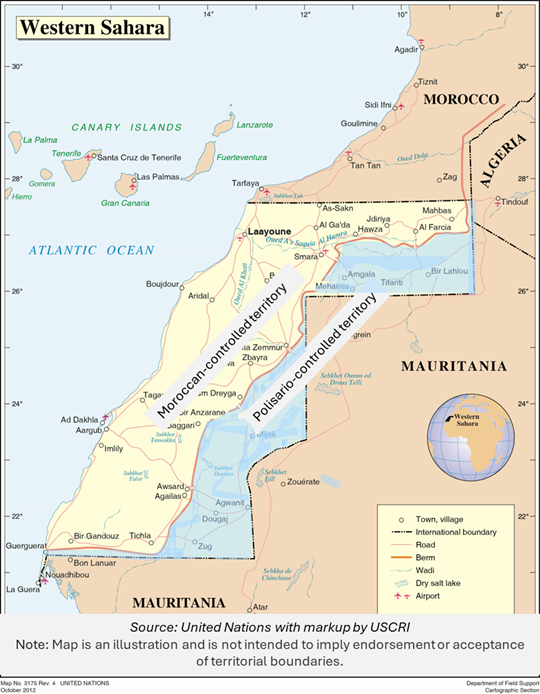
Press Release – USCRI Highlights...
The U.S. Committee for Refugees and Immigrants (USCRI) is disturbed by reports that U.S. Citizenship and Immigration Services (USCIS) has directed a sweeping review...
READ FULL STORY
Who are the Sahrawi People?
The Sahrawi people are a primarily nomadic cultural and ethnic group of Arab and Amazigh (also known as Berber) descent. Many Sahrawi people trace their lineage to Beni Hassan Arabs, who settled in North Africa between the 11th and 14th centuries. They share cultural ties with other ethnolinguistic groups in the Maghreb, and their identity is closely tied to the desert territory of Western Sahara.
Historically, Sahrawis were nomadic Bedouins, herding camels and goats across the Western Sahara region, which lies between Morocco, Algeria, and Mauritania. Their society was traditionally structured around tribes, such as the Regeibat and Oulad Delim—groupings that still hold cultural significance today, though political and social organization has shifted, especially in exile.

Historical Background: The Roots of Displacement
Colonial Period and Spanish Withdrawal
Western Sahara was a Spanish colony from 1884 until 1975. During the 20th-century decolonization wave, the Sahrawi nationalist movement emerged, led by the Polisario Front (founded in 1973), which advocated for an independent Sahrawi Arab Democratic Republic (SADR).
In 1974, as Spain prepared to decolonize Western Sahara, it announced plans to hold a referendum on self-determination, supervised by the United Nations (UN). Morocco opposed the referendum and, along with Mauritania, formally requested an advisory opinion from the International Court of Justice (ICJ) to support its historical and ancestral claims over the territory.
The ICJ examined Morocco’s claims of ties to Western Sahara and concluded that, while there were legal ties of allegiance between the Sultan of Morocco and some tribes in the territory, these did not amount to sovereignty over the region. The decision set the stage for occupation, resistance, and the long-running conflict that followed.
As Spain was preparing to withdraw from Western Sahara in 1975, King Hassan II of Morocco organized the Green March—a peaceful mass demonstration of about 350,000 unarmed Moroccan civilians who crossed into the territory to assert Morocco’s claim. This strategic move applied pressure on Spain just as it was facing internal political instability. It also sought to undercut calls for Sahrawi independence led by the Polisario Front.
Shortly after the Green March, Spain signed the Madrid Accords, transferring administrative control of Western Sahara to Morocco and Mauritania instead of holding the referendum on independence that had been promised to the Sahrawi people. Under the agreement, the territory was divided between foreign powers, with Morocco receiving the northern two-thirds and Mauritania the southern third.
As Morocco and Mauritania moved in, the Sahrawi people, led by the Polisario Front, resisted the military occupation, sparking the Western Sahara War (1975–1991).
Exodus and Refugee Camps
By early 1976, thousands of Sahrawis had fled the violence and crossed into southwestern Algeria, where the Algerian government provided land near Tindouf to establish refugee camps. By the late 1970s, most Sahrawi refugees had settled in these camps.
Algeria’s support for the Sahrawi cause intensified the region’s geopolitical tensions. Algeria and Morocco had long-standing rivalries rooted in border disputes, contrasting political ideologies, and competition for regional influence. Algeria opposed Morocco’s annexation of Western Sahara, seeing it as a violation of the Sahrawi people’s right to self-determination. Today, Algerian officials insist they are not a party to the conflict, the country has provided military, diplomatic, and humanitarian support to the Polisario Front and SADR, which Morocco sees as direct interference.
In 1979, Mauritania signed a peace treaty with the Polisario Front, fully withdrew from Western Sahara, and formally recognized the SADR. Following Mauritania’s withdrawal, Morocco unilaterally annexed the territory that Mauritania had relinquished.
The conflict between Morocco and the Polisario Front continued until 1991, when the UN brokered a ceasefire and established the UN Mission for the Referendum in Western Sahara (MINURSO) to monitor the ceasefire and organize a referendum on self-determination. The referendum promised in 1991 has never occurred, largely due to disagreements over voter eligibility and political will.
Current Situation: Protracted Refugee Crisis
Living Conditions
Approximately 170,000 Sahrawi refugees remain in Algerian-administered camps around Tindouf. These camps are among the world’s second longest-standing refugee situations, where refugees are warehoused with limited prospects and largely dependent on humanitarian aid. Basic services like healthcare, education, and food security are all highly vulnerable to fluctuations in donor support.
Political Stalemate
The conflict between Morocco and the Polisario Front remains unresolved. Morocco controls around three-quarters of Western Sahara, which hugs the entire coastline and is considered to be the Kingdom’s “Southern Provinces,” while the SADR is estimated to control the “Free Zone,” about one-quarter of the disputed territory in the interior.

As many as 84 countries recognized the SADR at one point. International recognition, however, has faltered, with only 47 countries still recognizing the Sahrawi Republic. Others— including the United States (since 2020), France, Israel, and Spain—have backed Morocco’s sovereignty, despite the UN classifying it as the world’s largest non-self-governing territory.
Recent Developments
Current Challenges Facing Sahrawi Refugees
Conclusion
The Sahrawi refugee situation is one of the most intractable and underreported humanitarian and political crises in the world. While the camps are often cited as models of self-organization, their continued existence highlights a failure of international diplomacy and political will. A durable solution requires a renewed commitment to human rights, international law, and the long-promised referendum on self-determination.

The U.S. Committee for Refugees and Immigrants (USCRI) is disturbed by reports that U.S. Citizenship and Immigration Services (USCIS) has directed a sweeping review...
READ FULL STORY
Arlington, VA — [November 25, 2025] — The U.S. Committee for Refugees and Immigrants (USCRI) is gravely concerned about the severe impact that the Administration’s decision to terminate Temporary Protected Status (TPS) for...
READ FULL STORY
Arlington, VA — [November 20, 2025] — Today, more than 60 national, state, and local organizations that work with immigrants and refugees across the United States joined together to urge the U.S. Government...
READ FULL STORY